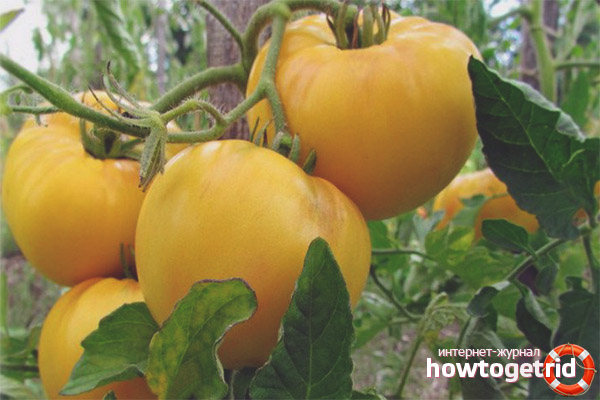The content of the article
The yellow giant is an indeterminate tomato variety with large yellow fruits. The taste of the fruit is sweet and sour, with a very pleasant smell and a faint aroma. Tomatoes are large, have a yellow fleshy flesh. Tomato The yellow giant belongs to the salad variety, but can be used for canning, slicing the fruit into slices.
Description
The fruit ripening period is extended by 1.5 months. The plant is not demanding on the type of soil, grows well in conditions of sufficient moisture. The variety is mid-ripening, from the moment of emergence of the shoots before harvesting it will take 12 days. Productivity is increased, with long fruiting.
Fruits are spherical, flattened, sometimes ribbed. The root system is located in the upper soil layer, not deeper than 40 cm, and is covered with numerous fibrous roots along the entire length.
Tomatoes grow well on light sandy loamy soils. Yellow giant tomatoes are not hybrids, you can collect seeds for cultivation on your site in subsequent years.
Landing and care
Tomato is not a capricious plant, therefore, difficulties with care usually do not arise. Large-fruited tomatoes are grown, as a rule, through seedlings. This approach allows you to get earlier products.
Growing tomato seedlings at room conditions has its own characteristics of care. If agricultural technology is not followed, then the seedlings may die, which often happens with novice gardeners.
Growing seedlings on the windowsill
Seeds are sown in mid-March, not earlier, since overexposed seedlings then adapt worse. Healthy, full-fledged plants are obtained from fresh seeds harvested last season. For sowing you will need:
- Capacity at least 5 cm high;
- A sheet of glass or plastic film according to the size of the landing tank;
- Soil mixture of earth, sand and peat;
- Ash, potassium permanganate solution;
- Seeds
Seeds before planting can be soaked for several hours in a stimulating solution. Germination is carried out on napkins. Planting material is recommended to be carefully treated with a fungicide to prevent fungal diseases.
Grooves are made in the soil into which seeds are sown. The gap between the grooves is 5 cm. It is advisable to sprinkle the seeds with sand. It will protect them from excessive moisture during watering and from the black leg.
- The containers are covered with glass or film to create a greenhouse environment. Sprouts of the Yellow Giant will appear after 7 days. Young plants gradually harden, opening shelter from glass or film. After 15 days, the seedlings are transferred to the windowsill to provide a sufficient amount of light. This is important, as seedlings, growing, can stretch out.
- Watering is done as the soil dries up with warm water, spraying it from the sprayer. You need to try not to flood the plant, otherwise the seedlings will be affected by a black leg fungal disease. At the first sign of illness, the sprouts are dug up together with a lump of earth and removed. The remaining hole is covered with fresh soil, and watered with fungicide.
- After the appearance of 4 leaves, tomatoes dive. Complex fertilizers are added to the soil for transplantation. Plants are buried in the ground in prepared pots by 3 cm. If the roots have grown greatly, you can prune them.
- Watering is carried out along the edges of the pot with warm water, while moisture should not fall on the leaves of plants. Seedlings are placed in a bright place on the windowsill, but not in direct sunlight, so as not to burn the young plants.
Growing in greenhouses and open ground
Seedlings are planted in greenhouses or open ground at the end of May. One of the decisive factors in increasing yields is soil loosening, weed control, watering and top dressing. Since the root system of tomatoes is superficial and sensitive to drying, it is recommended to mulch the soil with compost or humus after watering.
To feed plants on 1 m2 of area, 3-4 kg of humus or compost, 20-25 g of ammonium nitrate, 35 g of superphosphate, 10-12 g of potassium salt are added.
An important condition for obtaining a good harvest is proper watering. With waterlogging in the soil, the amount of air decreases, the activity of bacteria worsens, and the decomposition of organic substances slows down. The lack and excess of moisture equally negatively affects the growth and development of plants.
Bush formation
On young plants, 1-3 basic, well-developed shoots are selected and tied up vertically to the trellis. Pinch the tops of the shoots, tear off the lower leaves.
Diseases and Pests
Stem nematode is a dangerous pest of tomato plantations. This is a small, transparent, filiform worm 0.5-1mm long. In the process of feeding nematodes, substances that lead to the shortening and thickening of peduncles fall into the stems of plants. The fruits are smaller. As a result of the defeat by nematodes, the yield may drop to 68% or completely die. It takes 14 to 20 days to develop one generation of worms. To combat the nematode, the drug Tiazon is used, which is applied to the soil at the rate of 1-1.5 kg per 10 m2.
Yellow giant tomatoes have high yields. On average, one hectare can yield a crop of 90 tons. Tomatoes ripen normally if they are picked in green.
Video: Yellow Giant Tomato Varieties











Submit